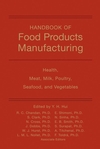This fall, a lawsuit was filed against the top 18 chicken processors (and subsidiaries, affiliates and two consulting firms) alleging they conspired to depress wages for the last 10 years. The lawsuit aims to grant class-action status for hundreds of thousands of employees. Regardless of how the litigation is ultimately resolved, it raises negative attention once again — fairly or not — on how processing plants compensate and value their employees, but this time during a tight labor market.
“For the last 10 years, the industry has been in transition, based on who is working there and how to meet their needs,” says Jessica Leibler, assistant professor of environmental health at Boston University. “This may have come to a head recently, but the transitional period is not new.”
State of the Industry 2019
OverviewBeef (NCBA)
Pork
Chicken
Food Safety
Packaging
Beef (CAB)
Turkey
Veal
Lamb
Animal Welfare
Seafood
Workforce
Watch the 2019 State of the Industry Webinar
Register for free today!
According to the North American Meat Institute (NAMI), 527,019 people work in the meat and poultry industry in production and packing, importing, sales, packaging and direct distribution of meat and poultry products. As of 2017, meat packaging and processing plants paid employees about $14.98 per hour plus benefits, with poultry processing plant employees making $13.58 an hour plus benefits.
Processing plants offer a unique workplace with specific challenges. The work is difficult — uncomfortable, physically taxing, messy and dangerous, and it often takes place in extreme heat or cold.
“In a tight labor market, these jobs are not at the top of the list,” says Leibler. “These are physically challenging jobs, so employees want their salaries to reflect that.”
The processing industry is also at an interesting junction. It relies on a fairly substantial immigrant workforce (including those with H-2A temporary agricultural workers visas) who are at risk of being deported and another strong workforce of those with generational ties to agriculture and processing work.
“These employees have different needs and bring different skills to the industry,” Leibler says. “It’s a challenge [for the industry] to recruit because they have very distinct needs, and it leads to some complexity to appeal to both groups.”
Both groups, however, want job security and safety at their workplace.
Finding skilled workers
“Slaughter/processing facilities tend to be heavily located in rural areas, which can have tighter labor markets than the numbers even suggest,” says Katelyn McCullock, director of the Livestock Marketing Information Center, based in Littleton, Colo. “It’s a challenge to find workers to fill the roles as necessary.”
For one, these are skilled-labor jobs. “Generally, they are not for someone who can be picked up off the street and put into this role,” McCullock says. “They require training.”
In regions with other opportunities, the labor numbers will fluctuate even more. “Not everyone likes working in a slaughter facility, so competing offers for greater compensation and on-the-job perks are appealing,” McCullock says. In Colorado, for example, the processing workforce is being hired away to oilfields in Wyoming.
“The workers don’t share direct skills, but companies are targeting the same labor force,” says McCullock. “There may be a significant pay differential and job perks, as well.”
It has to be worth it, after all, for employees to move when unemployment hovers around 3.7 percent.
Providing new opportunities
To keep employees, more plants are engaging in subtle approaches, such as emphasizing training, showing workers a possible management or leadership path, identifying leaders, offering compensation-related expenses such as overtime pay or giving out bonuses for those who show up to work a certain number of days in a row, McCullock says.
“It’s a real challenge to keep people there and fill the available amount of shifts,” she says. “So, management is changing their policies to keep them coming back.”
Both employees and managers share the goals of decreasing sickness and injury on the job, but the mechanism in how those goals are achieved differs, Leibler says.
“Latino employees appreciate if their training and resources are in Spanish,” says Leibler. “Also, if management can speak in Spanish, it improves morale, retention and safety.”
Longtime workers value competitive wages and a safe work environment, too. “Opportunities to increase learning on the job and move into different aspects of work are also popular,” Leibler says. “Support for child care, an investment in community — by sponsoring social activities and organizations like Little League — and engagement are appreciated.”
Preventing turnover
“The economy functioning with a tight labor market is positive, but a double-edged sword,” McCullock says. “This isn’t unique to agriculture or meat processing, though. Farm labor deals with the same problems of finding and keeping people for these roles.”
Companies are trying to prevent turnover by implementing worker-friendly policies, bonuses and compensation, while providing new opportunities to move workers through the management system for growth, she says.
“However, the long-term trend is leaning toward using automation in general and increasing reliance on robotics — even before the tight labor market,” McCullock says. NP









